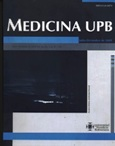Factores de riesgo para nefropatía inducida por agentes de contraste radiológico en pacientes sometidos a tomografía axial computarizada contrastada. Clínica Universitaria Bolivariana 2008
Contenido principal del artículo
Resumen
Introducción: la Nefropatía Inducida por Agentes de Contraste Radiológico (NIACR) se define como un daño renal de grado variable que se presenta después de la exposición del paciente a agentes de contraste radiológico. Existe un número significativo de factores de riesgo definidos para la patología, aunque la mayoría de los datos son extrapolados de estudios internacionales.
Métodos: estudio de series clínicas con una muestra por conveniencia de 85 pacientes sometidos a tomografía axial computarizada en el Centro de Imágenes Diagnósticas de la Clínica Universitaria Bolivariana.
Resultados: la edad promedio de la serie fue de 55 ± 19 años, con un valor de creatinina sérica de 0.92 ± 0.53 mg/dL. Se encontró que el 70.58% de los pacientes estudiados tiene, por lo menos, un factor de riesgo para la patología en el momento de ser sometidos al procedimiento imagenológico.
Conclusión: existe en nuestro medio una prevalencia alta de factores de riesgo para nefropatía inducida por agentes de contraste radiológico.
Referencias
Balparda JK, Gaviria ME. Nefropatía inducida por medios de contraste radiológico yodados. Iatreia. 2008; 21:166-76.
McCullough PA. Contrast-induced acute kidney injury. J Am Coll Cardiol. 2008; 51:1419-28.
Lameire N, Van Biesen W, Vanholder R. The changing epidemiology of acute renal failure. Nat Clin Pract Nephrol. 2006; 2:364-77.
Thomsen HS, Morcos SK, Barrett BJ. Contrast-induced nephropathy: the wheel has turned 360 degrees. Acta Radiol. 2008; 49:646-57.
Feldkamp T, Kribben A. Contrast media induced nephropathy: definition, incidence, outcome, pathophysiology, risk factors and prevention. Minerva Med. 2008; 99:277-96.
Bouzas A, Vásquez JM, Calviño R, Peteiro J, Flores X, Marzoa R, et al. Contrast-induced nephropathy and acute renal failure following emergent cardiac catheterization: incidence, risk factors and prognosis. Rev Esp Cardiol. 2007; 60:1026-34.
Finn WF. The clinical and renal consequences of contrast-induced nephropathy. Nephrol Dial Transplant. 2006; 21:2-10.
Sadegui HM, Stone GW, Grines Cl, Mehran R, Dixon SR, Lansky AJ, et al. Impact of renal insufficiency in patients undergoing primary angioplasty for acute myocardial infarction. Circulation.2003; 108:2769-75.
Stacul F. Reducing the risks for contrast-induced nephropathy. Cardiovasc Intervent Radiol.2005; 28:12-8.
Takovou I, Dangas G, Mehran R, Lansky AJ, Ashby DT, Fahy M, et al. Impact of gender on the incidence and outcome of contrast-induced nephropathy after percutaneous coronary intervention. J Invasive Cardiol. 2003; 15:18-22.
Wong GT, Irwin MG. Contrast-induced nephropathy. Br J Anaesth. 2007; 99:474-83.
Toprak O. Conlicting and new risk factors for contrast nephropathy. J Urol. 2007; 178:2277-83.
Al-Ghonaim M, Pannu N. Prevention and treatment of contrast-induced nephropathy. Tech Vasc Interv Radiol. 2006; 9:42-9.
Becker CR, Davidson C, Lameire N, McCullogh PA, Stacul F, Tumlin J, et al. High-risk situations and procedures. Am J Cardiol. 2006; 98:37-41
Dangas G, Iakovou I, Nikolsky E, Aymong ED, Mintz GS, Kipshidze NN, et al. Contrast-induced nephropathy after percutaneous coronary interventions in relation to chronic kidney disease and hemodynamic variables. Am J Cardiol. 2005; 95:13-9.
Nikolsky E, Mehran R, Lasic Z, Mintz GS, Lansky AJ, Na Y, et al. Low hematocrit predicts contrast-induced nephropathy after percutaneous coronary interventions. Kidney Int. 2005; 67:706-13.
DANE. Proyecciones nacionales y departamentales de población. 2006-2020 proyecciones nacionales y departamentales [Internet]. Bogotá: DANE; 2007 [acceso Septiembre 21 de 2009]. Disponible en: http:// www.dane.gov.co/files/investigaciones/poblacion/ proyepobla06_20/7Proyecciones_poblacion.pdf
Mitchell AM, Kline A. Contrast nephropathy following computed tomography angiography of the chest for pulmonary embolism in the emergency department. J Thromb Haemost. 2007; 5:50-4.
Krol AL, Dzialowski I, Roy J, Puetz V, Subramaniam S, Coutts SB, et al. Incidence of radiocontrast nephropathy in patients undergoing acute stroke computed tomography angiography. Stroke. 2007; 38:2364-6.
Dittrich R, Akdeniz S, Kloska SP, Fischer T, Ritter MA, Seidensticker P, et al. Low rate of contrast-induced nephropathy after CT perfusion and CT angiography in acute stroke patients. J Neurol. 2007; 254:1491-7.
From AM, Bartholmai BJ, Williams AW, Cha SS, McDonald FS. Mortality associated with nephropathy after radiographic contrast exposure. Mayo Clin Proc. 2008; 83:1095-100.
Urdí R. Why are males injured more than females? Inj Prev. 1998; 4:94-5.


